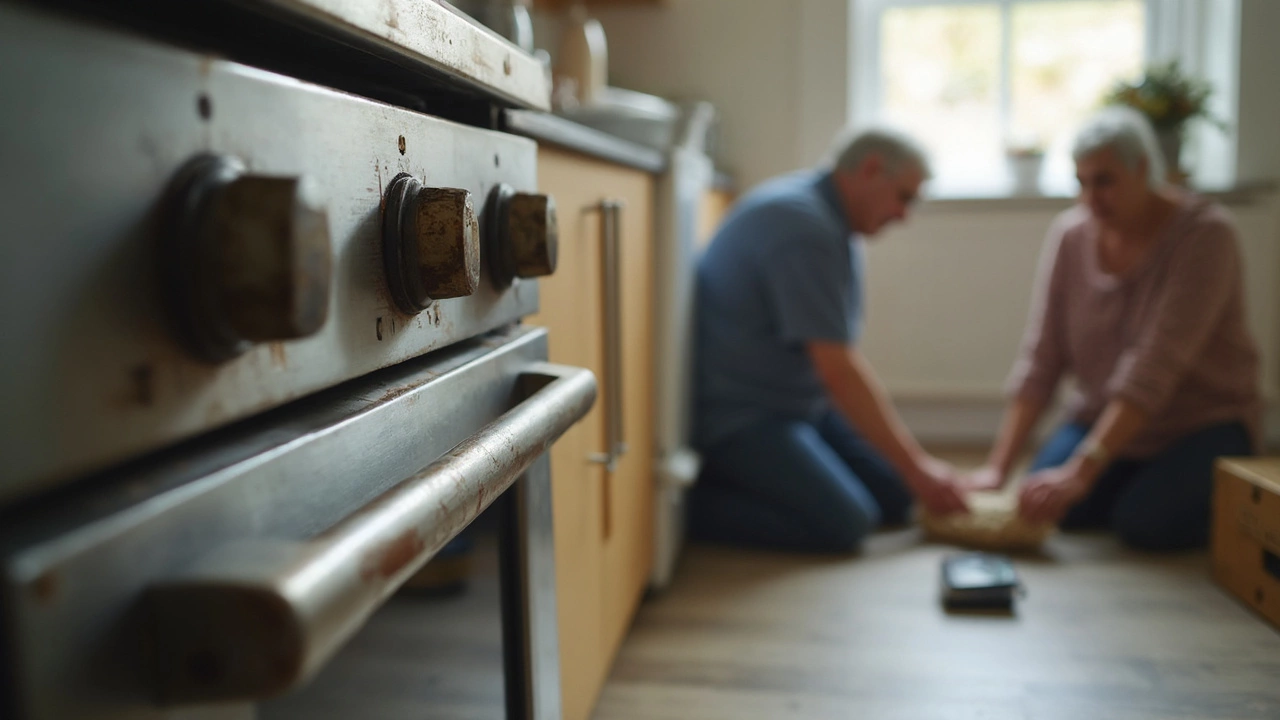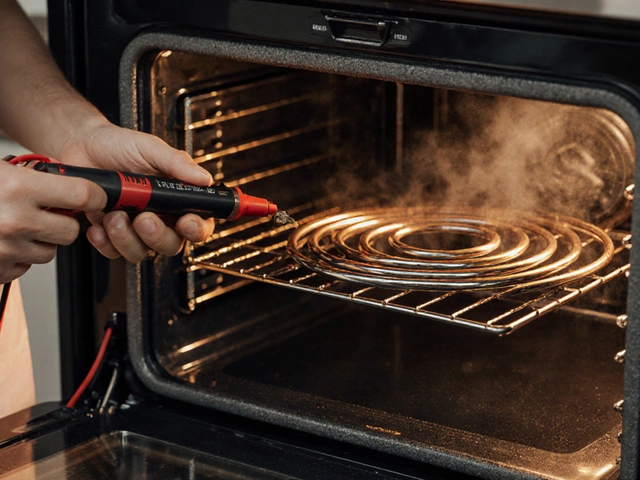Picture this: you’re about to bake your favorite pizza, but the oven takes years to heat up, or worse, it shuts off halfway. If your oven just hit the 10-year mark, you’re probably wondering if it’s smart to spend money fixing it, or if it’s time to move on.
The answer isn’t as simple as “old means replace.” Loads of people get extra years out of their ovens with just a minor part swap—like changing out a faulty thermostat or worn-out heating element. These repairs can actually be pretty cheap and quick if you know what you’re dealing with.
But there’s a tipping point. If the repair bill starts looking like half the price of a new oven, or your appliance is having new weird issues every month, it may not be worth the hassle or cash. The type of trouble—like a busted control board versus a broken door seal—matters a lot, too.
Before you shell out any money, it’s smart to check what’s really failing, how much repairs will run, and how much life your oven has left. A bit of homework upfront can save you from blowing cash on a sinking ship or dumping a perfectly good appliance for no reason.
- The Lifespan of an Oven: What to Expect
- Common Problems in 10 Year Old Ovens
- Cost of Repairs vs Buying New
- Warning Signs: When Repairs Aren’t Worth It
- Tips to Keep Your Old Oven Going Strong
- Making the Final Decision
The Lifespan of an Oven: What to Expect
Most ovens are built to last about 10 to 15 years. That’s what manufacturers admit, and it actually checks out for most families. If your oven has hit the 10-year mark, it’s in the “middle-aged” zone for kitchen appliances, not ancient but definitely not new either. Gas ovens often hang on a bit longer than electric ones—sometimes up to 18 years if you’re lucky and stay on top of simple maintenance.
Here’s what really makes a difference in how long your oven lasts:
- Oven repair and maintenance habits—cleaning the inside, making sure the door seal isn’t shot, and catching small issues early.
- Usage—if you bake cookies twice a year, your oven will outlast the neighbor’s if they run a bakery out of their kitchen.
- Parts quality—budget ovens sometimes use cheaper elements and electronics, which wear out faster.
- Power surges and kitchen moisture—these kill digital boards or controls quick.
There’s no timer that goes off at year 10. Some ovens chug along for years after, while others start acting up sooner, especially if maintenance hasn’t been a habit. If you’re careful with it, don’t slam the door, and fix little things fast, hitting 15 years isn’t rare. But, if repairs pile up or you can’t get parts anymore, that’s usually a sign it’s winding down.
Common Problems in 10 Year Old Ovens
Once your oven celebrates its tenth birthday, expect a few hiccups. Some issues are more of a nuisance, while others make you wonder why you’re still holding on at all. Here’s a quick platter of what folks usually face:
- Heating element burnout: This is hands down the most common headache. If you notice uneven baking or your oven barely gets warm, the lower or upper element could be fried. Good news? These are usually simple and cheap to swap out.
- Thermostat failure: If your cookies end up burnt on the outside but raw inside, blame a bad thermostat. Sometimes this little part stops reading the real temp, so your oven’s guesses are way off.
- Faulty door seals and hinges: Cracked seals and stiff hinges mean heat escapes and cooking times get longer. You’ll waste energy and might end up with poorly cooked meals.
- Control panel glitches: Seen random error codes or dealt with unresponsive buttons? At 10 years, the control board or buttons can start to fail. These repairs cost more, though, since parts aren’t always easy to get.
- Igniter issues (for gas ovens): If your gas oven takes ages to light or won’t stay hot, the igniter might be near retirement. You’ll hear clicking, but nothing will happen—or the oven shuts off halfway.
- Burned out lights: Not a big deal, but a dark oven is harder to check without opening the door and letting out heat.
If you want the numbers, take a glance at this table showing typical repair costs for these classic dramas:
| Problem | Average Repair Cost (USD) |
|---|---|
| Heating Element Burnout | $120–$250 |
| Thermostat Replacement | $110–$220 |
| Door Seal/Hinge Repair | $75–$180 |
| Control Board/Panel Replacement | $200–$450 |
| Igniter Replacement | $110–$200 |
| Light Bulb Replacement | $10–$30 |
Most of these problems come down to normal wear and tear—nothing you did wrong. The trick is figuring out which repairs keep your oven reliably cooking and which ones mean it’s ready to call it quits. Keep an eye on rising costs and dodgy performance.
Cost of Repairs vs Buying New
Let’s get straight to the numbers, because that’s what makes or breaks this decision. First, repairing a 10-year-old oven is almost always cheaper upfront than buying a new one—at least if it’s just a simple part like a heating element (which usually costs $50 to $100 for both the part and labor). But things get dicey if you’re looking at electronic control boards, sensors, or major wiring fixes. Those can run $200 to $400, depending on your oven brand and where you live.
Now, check out this quick rundown comparing repair and replacement costs. These are ballpark averages from 2024 service data:
| Repair | Average Cost (USD) |
|---|---|
| Heating Element or Igniter | $100 - $250 |
| Door Seal or Hinges | $80 - $180 |
| Control Board Replacement | $250 - $500 |
| Average Labor Fee (per visit) | $65 - $120 |
| New Oven | Average Cost (USD) |
| Basic Model | $500 - $900 |
| Mid-Range | $1,000 - $1,800 |
| High-End or Smart Oven | $2,000+ |
Does it sting to pay hundreds for repairs? For sure. But think about your actual oven use. If you barely cook, a cheap fix can squeeze out a few more years. Hardcore bakers or families who use the oven daily might find themselves shelling out for another repair sooner than later.
A good rule: if a oven repair costs more than half of what a new oven runs (including installation), it’s usually not worth the gamble. Also, a new oven often means better energy efficiency, more even baking, and a longer warranty—none of which you’ll get by patching up an old model.
- Check if your oven has any remaining warranty. Manufacturers sometimes offer extended warranties that cover major parts even after 10 years.
- If your kitchen is full of matching appliances from the same era, a replacement may start a style domino effect (ask me how I know—Ella wasn’t thrilled with a lone new oven next to our old fridge).
- Factor in installation. Some stores include it for free, but others tack on $100–$300.
At the end of the day, only you know how much convenience and peace of mind are worth versus pinching a few pennies holding onto that old faithful oven.

Warning Signs: When Repairs Aren’t Worth It
If your oven has been a kitchen workhorse for a decade, there comes a point where fixing it just isn’t smart anymore. So how do you spot that line?
First up, check the price tag of any repair. If a fix costs oven repair experts say over 50% of what a basic new model would, it’s usually a waste. Imagine a part costs $350 and entry-level ovens start at $600. That’s not a great deal, especially since future breakdowns are more likely as the oven ages.
Another big red flag: recurring or multiple issues. When one thing breaks right after another—or everything goes haywire together—it’s a sign your oven’s wearing out as a whole. This is called “cascade failure,” and it means small fixes won’t stop the spiral.
If your oven is unsafe—like it smells like gas, has exposed wires, or keeps tripping breakers—don’t risk a repair. Safety problems aren’t worth patching, and new ovens have stricter safety standards too.
Also, if replacement parts are discontinued or super expensive, that’s a dead end. For older models, especially some brands, the parts may be impossible to find. Even if you do find them, you might pay triple what you would for modern equivalents.
Here’s a handy breakdown to decide when to skip repairs:
- Repair is more than half the cost of a new oven
- You’re calling for fixes every year or more
- Major components (e.g., control board, heating element, seals) are all failing
- Oven has gas leaks, exposed wiring, or electrical faults
- No longer possible to get genuine parts
Check out this comparison of repair costs versus the price of a new oven:
| Repair Type | Average Cost (USD) | Worth Repairing? |
|---|---|---|
| Heating Element Replacement | $170 | Yes, if oven works well otherwise |
| Control Board | $350-$600 | No, usually better to replace |
| Thermostat Replacement | $120 | Usually worth it |
| Gas Leak Repair | $400+ | Not recommended for old ovens |
Don’t let nostalgia or sunk-cost feelings blind you—sometimes, moving on saves you money, time, and headaches. Know when to walk away, and your kitchen (and wallet) will thank you.
Tips to Keep Your Old Oven Going Strong
If you want to squeeze a few more good years out of your oven, it comes down to easy habits and a little routine attention. I used to skip a lot of maintenance until a tech friend showed me how much it matters. It’s not complicated, and you don’t need fancy tools.
Start with cleaning. Burnt food and grease can really throw off how the oven heats. Scrub the racks and wipe down the cavity (especially the door gasket). Avoid spraying cleaner right on heating elements, just use a wet rag if needed. A clean oven actually cooks food more evenly, and it puts less stress on the parts.
- Oven repair pros will tell you to check the door seal twice a year. If the seal is torn or loose, your oven loses heat and wastes energy. Replacement oven gaskets are usually less than $20 and anyone can install them.
- Test the temperature with an oven thermometer. If your set temperature and the thermometer reading are off by more than 25 degrees, your thermostat or sensor is probably starting to go. Some sensors can be swapped for under $30, and you don’t need to be a pro.
- Don’t ignore small problems. If you hear odd clicking, see sparks or the oven starts shutting off randomly, fix it fast. Waiting usually turns a quick fix into a bigger (and more expensive) problem down the line.
- Once a year, pull out the oven and gently vacuum crumbs or dust from behind and underneath. Built-up grime makes the oven run hotter and can wreck the wiring.
- If your oven has self-clean mode, use it sparingly. The extreme temps can shorten the lifespan of electronic parts—especially in older ovens.
Here’s a simple table to show what common maintenance can save you, compared with ignoring little issues:
| Task | Estimated Cost | Potential Savings | How Often |
|---|---|---|---|
| Replacing door gasket | $15-20 | 7-12% in energy yearly | Every 3-5 years or as needed |
| Sensor or thermostat swap | $20-45 | Prevents uneven baking/ruined meals | When temperature is off |
| Cleaning racks/cavity | $3-10 (supplies) | Avoids costly part failures | Monthly or as needed |
Small steps really do make a difference. Stay on top of maintenance, and even an oven pushing 15 can keep cranking out good meals.
Making the Final Decision
This is really where the rubber meets the road: is it worth pumping money into that old oven, or are you better off ditching it for a new one? Let’s lay out the exact stuff you should look at before making a move, including what the experts and data suggest.
Oven repair can be a smart choice if your fix costs less than 50% of what a new, similar oven would set you back. A 2024 report from HomeAdvisor pegs the average oven repair bill at around $225, while a new basic oven starts at $500 and can easily pass $2,000 for something fancier. So, basic math helps:
| Oven Age | Average Repair Cost | New Oven Cost |
|---|---|---|
| 5 years | $180 | $500+ |
| 10 years | $225 | $700+ |
| 15+ years | $300 | $850+ |
Don’t just go by dollars, though. If your oven’s been pretty reliable and hasn’t had a string of weird breakdowns, a single repair (especially for stuff like a bad bake element or thermostat) usually makes sense. But if you’re calling the repair guy every few months, it’s probably time to wave goodbye.
Here’s how folks usually break it down:
- If it’s a minor problem (one heating element, door gasket, or thermostat), repairing almost always pays off.
- If major stuff is busted (like the control board, or multiple parts at once), adding it all up often makes replacement the better bet.
- If the oven’s been reliable but just now broke down for the first time at 10 years old, repairs often give you a few extra solid years for less money.
- If it’s failing safety checks—like bad gas leaks or sparking circuits—don’t mess around. Replace it, no question.
Got warranty left? Some oven brands cover core parts for up to 12 years, so double-check before putting any cash on the table. Even out of warranty, a quick call to the manufacturer can sometimes score you a discount on parts.
One last nugget of wisdom comes from Mike MacDonald, service tech at Fixit Appliance in Chicago, who says:
"If you’ve got more than one big repair in as many years, that’s usually your cue to start shopping for something new."
Bottom line: run the numbers, measure your oven’s track record, and check if your headache is short-term or a sign your oven is on its last legs. If you don’t use it every day or just live off frozen pizzas (hey, no judgement), you might stretch it a little longer. But if every meal depends on that oven, swapping it out before the next big breakdown can save your sanity, not just your wallet.





